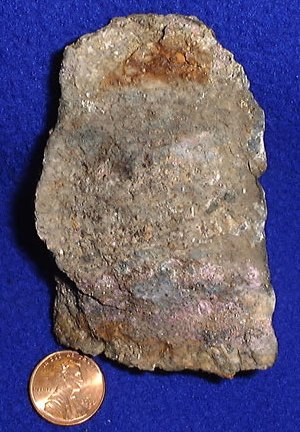Cobalt





Cobalt is a chemical element with the symbol Co and atomic number 27. It is found naturally only in chemically combined form, with the most common forms being in minerals. Cobalt is a hard, lustrous, silver-gray metal that is a byproduct of the mining of nickel and copper. Due to its magnetic properties, cobalt is used in the production of alloys that retain their strength at high temperatures and are used in the manufacture of jet engines, gas turbines, and magnetic materials. Cobalt is also an important component of rechargeable batteries, including lithium-ion batteries, which are widely used in electric vehicles and portable electronics.
Properties and Occurrence[edit]
Cobalt has a relative density of 8.9 and a melting point of 1495°C. It is ferromagnetic up to 1121°C, which is the highest temperature of any material. Cobalt's properties, such as wear resistance, high temperature strength, and resistance to corrosion, make it valuable in a variety of applications.
The element is most frequently obtained as a byproduct of mining and refining nickel and copper. Major cobalt production occurs in the Democratic Republic of the Congo, which is the largest producer, followed by Russia, Australia, and Canada.
Uses[edit]
Cobalt's uses can be categorized into several areas:
Alloys[edit]
Cobalt-based superalloys are used in the aerospace industry for parts of jet engines that are subjected to high temperatures and stress. It is also used in the production of steel for its properties of adding strength and resistance to wear and corrosion.
Batteries[edit]
Cobalt is a critical material in the production of rechargeable batteries, including lithium-ion, nickel-cadmium, and nickel-metal hydride batteries. These batteries are used in a wide range of applications from electric vehicles to portable electronic devices.
Catalysts[edit]
Cobalt is used as a catalyst in the petroleum and chemical industries, particularly in processes such as Fischer-Tropsch synthesis for converting natural gas into liquid fuels.
Colorants[edit]
Cobalt salts are used to produce a distinctive deep blue color in glass, ceramics, inks, paints, and varnishes. Cobalt blue is a notable pigment that has been used in art and decoration for centuries.
Health and Safety[edit]
Cobalt is an essential element for human health in very small amounts as part of Vitamin B12. However, exposure to cobalt dust or compounds can be harmful, causing skin and lung issues, and prolonged exposure can lead to more serious health problems. Safety guidelines and exposure limits have been established to protect workers in industries where cobalt is processed or used.
Environmental Impact[edit]
The mining and refining of cobalt can have significant environmental impacts, including habitat destruction, water pollution, and air pollution. Efforts are being made to reduce the environmental footprint of cobalt mining and to recycle cobalt from used batteries and other sources.
![]()
This chemical element related article is a stub. You can help WikiMD by expanding it.
Ad. Transform your life with W8MD's Budget GLP-1 injections from $75


W8MD offers a medical weight loss program to lose weight in Philadelphia. Our physician-supervised medical weight loss provides:
- Weight loss injections in NYC (generic and brand names):
- Zepbound / Mounjaro, Wegovy / Ozempic, Saxenda
- Most insurances accepted or discounted self-pay rates. We will obtain insurance prior authorizations if needed.
- Generic GLP1 weight loss injections from $75 for the starting dose.
- Also offer prescription weight loss medications including Phentermine, Qsymia, Diethylpropion, Contrave etc.
NYC weight loss doctor appointmentsNYC weight loss doctor appointments
Start your NYC weight loss journey today at our NYC medical weight loss and Philadelphia medical weight loss clinics.
- Call 718-946-5500 to lose weight in NYC or for medical weight loss in Philadelphia 215-676-2334.
- Tags:NYC medical weight loss, Philadelphia lose weight Zepbound NYC, Budget GLP1 weight loss injections, Wegovy Philadelphia, Wegovy NYC, Philadelphia medical weight loss, Brookly weight loss and Wegovy NYC
|
WikiMD's Wellness Encyclopedia |
| Let Food Be Thy Medicine Medicine Thy Food - Hippocrates |
Medical Disclaimer: WikiMD is not a substitute for professional medical advice. The information on WikiMD is provided as an information resource only, may be incorrect, outdated or misleading, and is not to be used or relied on for any diagnostic or treatment purposes. Please consult your health care provider before making any healthcare decisions or for guidance about a specific medical condition. WikiMD expressly disclaims responsibility, and shall have no liability, for any damages, loss, injury, or liability whatsoever suffered as a result of your reliance on the information contained in this site. By visiting this site you agree to the foregoing terms and conditions, which may from time to time be changed or supplemented by WikiMD. If you do not agree to the foregoing terms and conditions, you should not enter or use this site. See full disclaimer.
Credits:Most images are courtesy of Wikimedia commons, and templates, categories Wikipedia, licensed under CC BY SA or similar.
Translate this page: - East Asian
中文,
日本,
한국어,
South Asian
हिन्दी,
தமிழ்,
తెలుగు,
Urdu,
ಕನ್ನಡ,
Southeast Asian
Indonesian,
Vietnamese,
Thai,
မြန်မာဘာသာ,
বাংলা
European
español,
Deutsch,
français,
Greek,
português do Brasil,
polski,
română,
русский,
Nederlands,
norsk,
svenska,
suomi,
Italian
Middle Eastern & African
عربى,
Turkish,
Persian,
Hebrew,
Afrikaans,
isiZulu,
Kiswahili,
Other
Bulgarian,
Hungarian,
Czech,
Swedish,
മലയാളം,
मराठी,
ਪੰਜਾਬੀ,
ગુજરાતી,
Portuguese,
Ukrainian